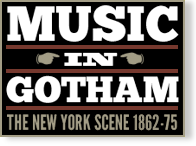Thomas Central Park Garden Concert
Event Information
Venue(s):
Central Park Garden
Conductor(s):
Dudley Buck
Price: $.50; $1 & $2 extra, private boxes
Event Type:
Orchestral
Record Information
Status:
Published
Last Updated:
7 July 2025
Performance Date(s) and Time(s)
15 Jul 1875, 8:00 PMPerformers and/or Works Performed
Citations
“The concert at the Central Park Garden on Thursday evening opened with a beautiful performance of Mozart’s overture to ‘The Magic Flute,’ a great masterpiece of which one never tires. It was succeeded by an early work of Beethoven’s, quite in the Mozart style, which has not been played here until within the last few days, at least in its present form. This is the ‘Serenade,’ Opus 8, written as a trio for violin, viola, and violoncello, and now arranged for full orchestra by Gustave Janke. We believe some portions are omitted in the performance. As played on Thursday it comprises five short movements, namely, an Allegro, an Adagio, with Scherzo, a Polacca, a characteristic and familiar Andante with variations, and a repetition of the Allegro for the finale. Thus it approaches a symphony in plan and dimensions. Formerly the name Serenade was often given to chamber music constructed on this scale, and of late it has been applied by Brahms to orchestral compositions which have rather more variety than the symphony, with perhaps rather less serious character. This bright and charming work of Beethoven’s is admirably adapted for the purpose to which Janke has applied it, and the audience received it with great satisfaction. The first part of the programme also contained the Vorspiel to Bruch’s ‘Loreley’ and Liszt’s ‘Goethe Festival” March, which certainly presented a remarkable contrast to the two pieces that preceded them; and the second part consisted of Hofmann’s picturesque and highly interesting ‘Frithiof’ symphony, a beautiful work most beautifully played. Mr. Thomas will return to town next week and resume his accustomed place.”
“The ‘Frithjof’ symphony was first performed at one of the symphony concerts last winter and recognized with that glad surprise which greets a work of true genius. There is something in the instrumentation of this Symphony which approaches the wonderful style of Raff; but the spirit of the composition is entirely original. The delightful intermezzo (‘Elves of light and Frost Giants,’) is a picturesque, half-comical delineation, which has already become a frequent and welcome addition to the repertoire of the Garden Concerts.”

